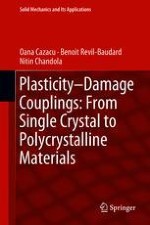Offering a well-balanced blend of theory and hands-on applications, this book presents a unified framework for the main dissipative phenomena in metallic materials: plasticity and damage. Based on representation theory for tensor functions and scale-bridging theorems, this framework enables the development of constitutive models that account for the influence of crystallographic structures and deformation mechanisms on the macroscopic behavior. It allows readers to develop a clear understanding of the range of applicability of any given model, as well as its capabilities and limitations, and provides procedures for parameter identification along with key concepts necessary to solve boundary value problems, making it useful to both researchers and engineering practitioners. Although the book focuses on new contributions to modeling anisotropic materials, the review of the foundations of plasticity and models for isotropic materials, completed with detailed mathematical proofs mean that it is self-consistent and accessible to graduate students in engineering mechanics and material sciences.
